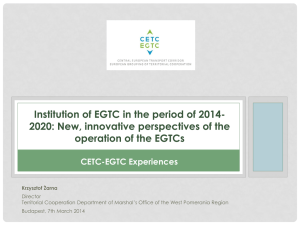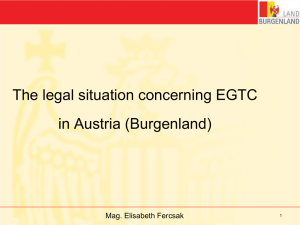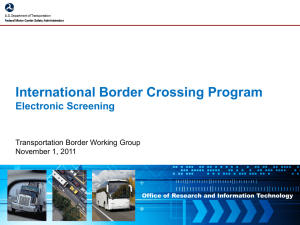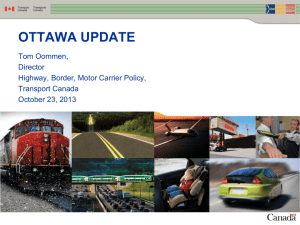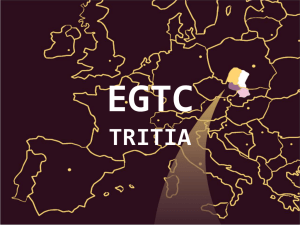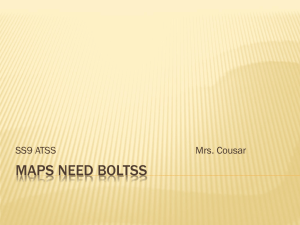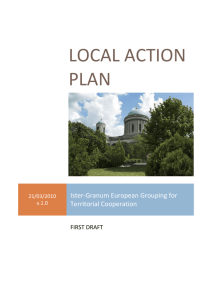L`AECT HOSPITAL DE LA CERDANYA LE GECT HÔPITAL DE
advertisement
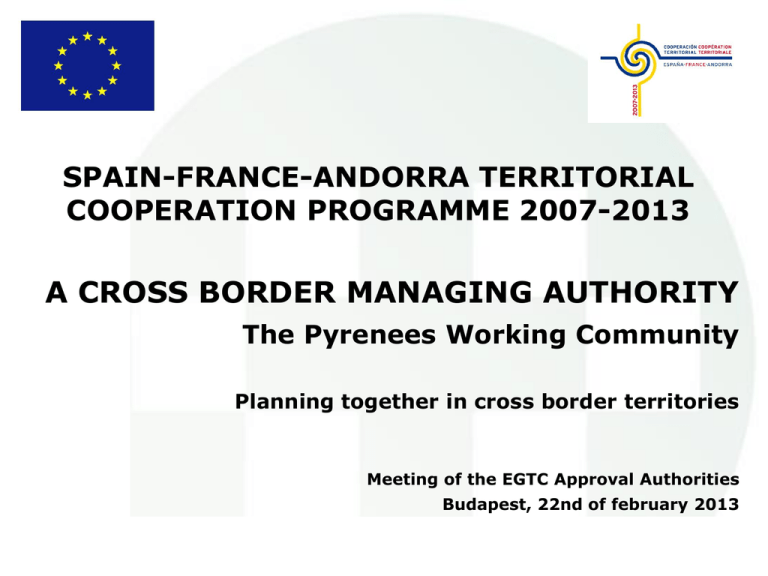
SPAIN-FRANCE-ANDORRA TERRITORIAL COOPERATION PROGRAMME 2007-2013 A CROSS BORDER MANAGING AUTHORITY The Pyrenees Working Community Planning together in cross border territories Meeting of the EGTC Approval Authorities Budapest, 22nd of february 2013 Introduction The Pyrenees Working Community manages the current Spain-France-Andorra ETC programme: It is a Consortium: a cross-border organization which represents the 7 regions of the border plus Andorra. The Consortium is an entity which was created by the franco-Spanish Bayonne Treaty in 1995. This franco-spanish legal framework for the Consortium is quite similar to EU Regulation through EGTC The ETC programme finances the project of the cross border Hospital with a 65% ERDF contribution Zones Éligibles du Programme Interreg IV A France-Espagne 2007-2013 Tarn-et -G aron ne Lan des Tarn Ge rs Hau te-G aro nne Pyréné es-A tla ntiqu es Bizkaia Au de Gipuzkoa Hau tes-P yrén ée s Ariège Alava Andor ra Nav ar ra Pyréné es-O rie nta le s Hue sca La Rioja Lle id a Giron a Ba rce lo na Zarag oza Zone É ligible Tarrago na Zone de Co ntigü ité Zone É ligible h ors UE SPAIN-FRANCE-ANDORRA TERRITORIAL COOPERATION PROGRAMME 2007-2013 THE CROSS BORDER HOSPITAL OF CERDANYA The EGTC of the Hospital of Cerdanya Planning together in cross border territories Meeting of the EGTC Approval Authorities Budapest, 22nd of february 2013 CERDANYA /CERDAGNE PARIS MONTPELLIER MADRID BARCELONA BASIC DATA ABOUT THE TERRITORY OF CERDANYA Territory with common history and culture (Language) 30.000 inhabitants. Touristic peaks of 150.000 2 EU members 2 Health Administrations, with different health Systems and health care organizations. Asymmetric competences (Central Government – Regional Government) Asymmetric health care offer: • South: Local Hospital of Puigcerdà: • North: Long care, rehabilitation • Different PHC approach Same health needs for population: • • • Improve access to health care Assure permanent and continuous care Quality and security assurance. Montpellier Toulouse Distance and time to get to the current Hospitals from Puigcerda to Perpignan Prades Puigcerdà Berga Manresa Sabadell Prades 60 Km. 1h 15’ Perpignan 105 Km. 2h 05’ Montpellier 257 Km. 3h 35’ Toulouse 171 Km. 2h 15’ Berga 60 Km. 55’ Manresa 99 Km. 1h 25’ Sabadell 135 Km. 1h 55’ Barcelona 150 Km. 2h 15’ Barcelona © 2009 Google Maps. © 2009 TerraMetrics. © 2009 Tele Atlas. 1997. Professional Cooperation. 2002. Services of the Puigcerdà hospital for the Cerdanya (Emergencies and delivery). 2003. Feasibility of Crossborder Common Hospital Cerdanya 2006. Hospital in both health network INSTITUTIONAL CONCEPTION Consortium Bayonne treaty ? 2006. Private Foundation Catalan law 2008 EGTC Works Bid Comanagement and executive board PROJECT OBJECTIVES 1. To create a common hospital which should be the main axis of a network of cross border health services regarding the rights and duties of the citizens in the two states 2. To create a cross border organization for the construction and management of a hospital for acute patients which should attend to the needs/services of all the population in Cerdanya and Capcir. 3. To set up an organization based on a sole culture which should integrate the advantages of the two health systems. 4. To guarantee a single and participative Governance. A single management approach too and a single health service’s provision model. 5. A hospital established in a single territory where both health planning systems have been taken into account. MAIN ISSUES A. Differences regarding tools, rhythms and different administrations policies (local, regional, national, European). Various administrations different degrees of political decentralization. B. Difficulties to identify the corresponding counterparts. Communication problems between administrations. Coordination difficulties. C. Project with a strong ideological component (European construction) tied to political events. (local, regional, national and European constitutional elections) D. Difficulties in recruiting professionals and in addressing general public directly. Difficulties in responding to expectancy in real time. E. Difficulties to coordinate the actors (local, regional, national) F. Difficulties in solving certain issues: free movement for patients, expenditure reimbursement, quality guarantee, workers professional certification Legal steps Transitory Foundation . Governance decisions 60% Catalunya 40% France Participation of local governments Decision process Legal adaptation Spain (02/2008) France (04/2008) France – Spain Health Agreement (09/2008) EGTC Legal set up (2008-2009) EGTC approval by both states (2010) The EGTC HC organization Presidency: it changes every 2 years between the French State and the Catalunya Region. It has a representation role. General Director: he is charge of the EGTC management Executive board: It gathers representatives of the EGTC members. It takes the key decisions about the way the EGTC has to be run. Advisory Committee: Representation of local governments from the territory of Cerdanya. It advises the Executive board on its tasks. The EGTC HC organization Executive Board (14 members) 8 members from the Catalan part 6 members from the French part 6 representatives of the Spanish Ministry of health 4 representatives of the French Republic Government 1 representative of the catalan health service 1 representative of the Regional Health Agency of the Languedoc-Roussillon region 1 representative of the Spanish Government 1 representative from the French Social Security Advisory Committee (14 members) Action Plan Executive Construction project of the Hospital: bid announcement in September 1st of 2008) Construction works ending in 2012 Opening of the Hospital in 2013 Implementation Plan of the cross border hospital The hospital construction A 31 million euros budget: 18,6 million of ERDF contribution through the Spain France Andorra Territorial Cooperation Programme 2007-2013 Main feature of the forthcoming offer in the Hospital: 32 bedrooms and 64 beds Main services: surgery (very complete offer), cardiology, pediatrics, dermatology, emergency, complete imaging department 200 people will work for the hospital The cross border hospital implementation plan Main objectives To respond to the needs of people from both sides of the border To facilitate the access to the health care system for people living next to the border and far from the big cities like Barcelona or Perpignan To look for complementarity between health services of both countries The cross border hospital implementation plan Main solutions through cooperation Both Social Security systems will work in this hospital thanks to an agreement between both states which will allow to take charge of the French and Spanish patients on both sides of the border. This agreement will be approved very soon. As regards medical prescriptions, given that the patient will have to find the right medicine in his own country, the doctors will write down the components of the medicine and not the mark/brand. The cross border hospital implementation plan Main solutions through cooperation Unique organization to respond to emergencies: both emergency services from both countries will work altogether and will have the capacity to intervene on both sides of the border thanks to a cooperation convention between Catalunya and France. The administrative burden for parents of French babies born in Spain (in the hospital) will be made easier thanks to a specific staff in charge of this task. Moreover, these babies could have the opportunity to have the double nationality. The cross border hospital implementation plan Main solutions through cooperation The medical staff will not be employed directly by the EGTC: a specific convention will be signed between the EGTC and other health services of the region in order to send part of its staff to the new cross border hospital (until EU Regulation improves on this subject) The other services of the hospital (communication, security, gardening, housekeeping, laundering, cooking, computer service) will be externalized to french partner private or public companies through different bid announcements The cross border hospital implementation plan Main solutions through cooperation For French people, the overcost (due to lead-covered coffins) of dead bodies transferred to France will be paid by French Social Security (at least until a better solution is found). The French State is currently working on an international convention between both states in order to avoid additionnal costs for bodies transferred to France for the specific case of the cross border Hospital. THANK YOU VERY MUCH
